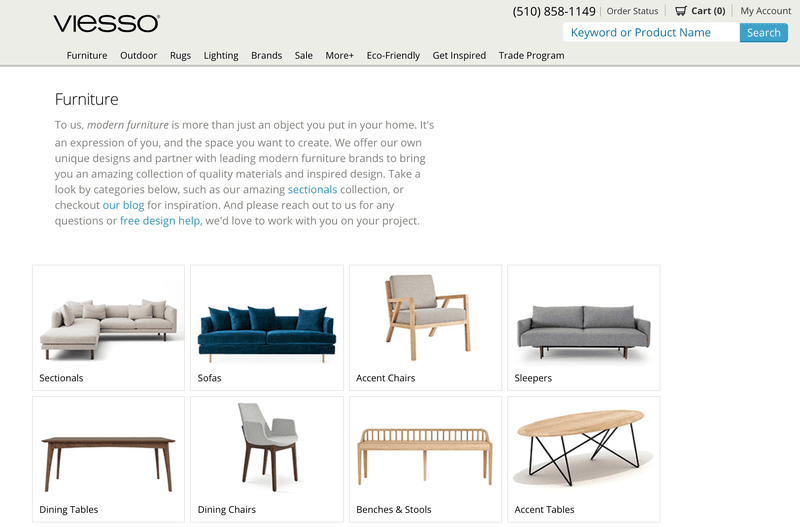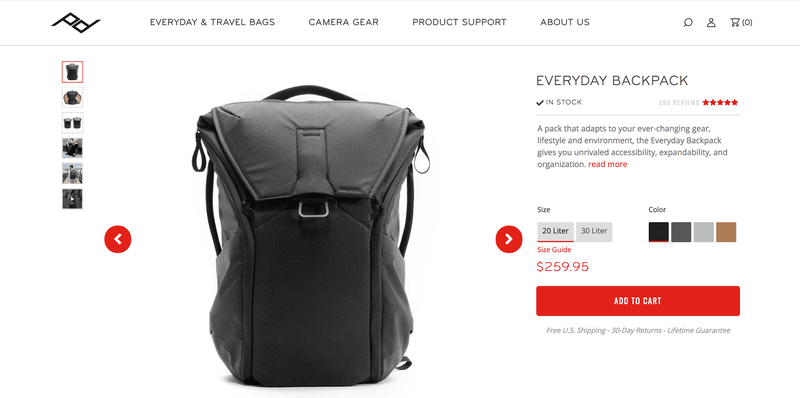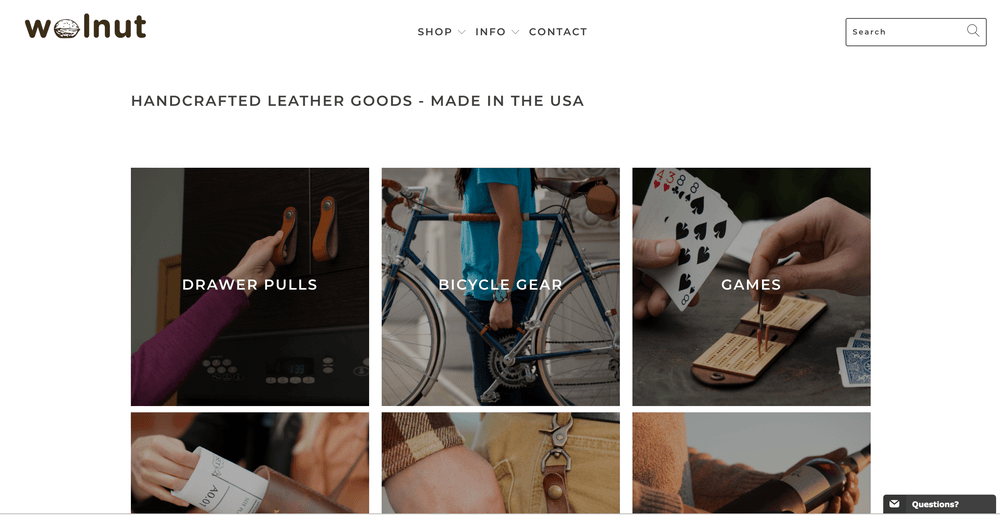$2.8 trillion in sales – that’s how much eCommerce stores made in 2018.
And this number is only increasing each year. According to Statista’s prediction, it’ll surpass $4.5 trillion in 2021!

These figures are quite impressive, to say the least. It’s no wonder that so many entrepreneurs have decided to join in and open up their own eCommerce stores.
In this article, we’ll break down the most profitable types of eCommerce business models, point out the most common mistakes, and, of course, offer up successful examples to inspire you.
Here’s what we’ll discuss:
1. Drop-shipping
In the Drop-shipping model, the goods you sell are both manufactured and shipped by other people. Your role is essentially to provide marketing for these third-party products.
This method works great for B2C products that you can continuously keep selling to the same customer. The goal here is Lifetime Value: Your success is measured not by immediate sales but by accumulated purchases over the long haul.
Successful Example
Travis Nagle and his brother founded Viesso with the intention of improving eCommerce in the furniture space. The company took off exclusively thanks to organic growth – no external investments – but it quickly took a hit during the Recession.

As a response, they turned to Dropshipping just to stay afloat. But then, this approach actually showed glimmers of possibility:
“We immediately saw the power of the dropshipping model in terms of low cost of doing business and more aggressive revenue growth,” says Nagle.
They focused more and more on offering unique products that people desired but couldn’t easily access. And within 2 years, their business encompassed 50+ brands to the tune of over $1 million in revenue.
Currently, they’re still enjoying big paydays (with one that surpassed $100k in early 2019) and long-standing customer relationships.
Benefits
Especially in the beginning, you can rest easy knowing there’ll be:
👍 Minimal Risk
Because you’re not responsible for the manufacturing, you don’t subject yourself to the risks that come with it. Any costs and hazards that come with products’ materials, machinery, or packaging are out of your hands.
Instead, you can channel your energy into low-risk aspects of the business such as marketing.
👍 Low Initial Investments
Plain and simple: You don’t need to pre-order a large inventory. Maintaining a full warehouse is the manufacturer’s concern, not yours.
So, with Drop-shipping, you don’t have to stress about a big hit to your wallet right out of the gate.
Potential Issues
Here’s where it’s worth paying attention.
👎 Slow Delivery
When you work with vendors responsible for delivery, you can’t control its speed or even ensure that the products will arrive. The process is pretty much out of your control.
But here’s the thing – your customers see won’t see it that way. For them, the whole sales process is the responsibility of the store they purchased from. Meaning you’ll be shouldering the blame if anything goes wrong.
👎 Unpredictable Quality Of The Product
Here’s an “Expectations vs. Reality” photo from AliExpress:

…Unfortunately, that is an all-too-common reality.
If you don’t want your customers to send you the same photos as you see here, make sure to actually check each product you sell.
👎 Strong Competition
Many people use this Drop-shipping business model, so the chance of there being similar products on the market is very high.
In order to beat your competition, you need to have outstanding marketing and customer support. Only then can you start to make good money.
👎 Low Margins
The reality with Drop-shipping is that you might not be making much, especially from your first sales. It’ll depend on how low your revenue is and how high your operational costs are, but substantial profit may be hard to come by.
That’s why creating Lifetime Value is so important here. Your success relies on customers returning time and time again to create that long-term profit you seek.
2. Wholesale
In this form of eCommerce, you start off by buying a large number of products in advance. Because you buy in bulk, the cost here is considerably lower. Once you acquire the goods, you store them until reselling at a higher price to relevant retailers or even individuals.
Essentially, your profit comes from being a useful middle man.
Wholesale often works well for B2B products that can be bought en masse.
Successful Example
Let’s take a look at a hydroponic company Growers House which works B2B with large gardens and other growing operations. They sell equipment that helps plants grow in nutrient-rich water instead of soil.

Grower’s House Instagram
Owners Paul Lipton and David Keith quickly scaled their products to a profitable level. After experiencing 1,233% growth over 3 years, they were named by Inc. as one of the fastest-growing private companies!
As the website states, their wholesale division “is trained to lower… costs… while increasing yield, quality, and quantity.” Incidentally, that short mantra touches heavily on Wholesale’s pros and cons:
Benefits
👍 High Margins
With Drop-Shipping, production costs can get pretty high because the items are bought individually. Here, however, you know that your initial purchase will be fairly cheap because you’re buying it in bulk.
With a larger quantity, your per-product cost will be noticeably lower. And, thus, you have to ability to set a higher margin. As long as you can find buyers, you’ll enjoy a steady stream of profit.
👍 Lower Competition
There are tons of B2B niches with uncovered needs. Which means it’s much easier for you to target your audience, especially when compared with the Drop-shipping approach.
Instead, you can carve out your niche and single-handedly own it.
Potential Issues
Yet, Wholesale requires some leaps of faith. That’s because this eCommerce model naturally necessitates sizable risk and investment.
👎 High Risk
While the potential reward is sizable, Wholesale carries its own fair share of risks. For instance, you could encounter supplier difficulties or product malfunctions.
More importantly, what if you acquire a large inventory but aren’t able to sell it all? This is the question that plagues tons of Wholesale businesses.
Furthermore, the same level of product liability that we discussed in Drop-shipping exists here as well, only to a greater degree.
👎 High Investments At The Start
With Wholesale, you simply have to make a big initial investment. The first step of this method requires you to buy or rent a product in bulk.
This means more cash is coming out of your pocket on day one. And if things go south, this will, unfortunately, become a sunk cost.
3. Private Label
When someone creates a product for you, but the contract allows you to put your name on it, it’s called Private Label.
In this case, the product is developed exclusively for you and according to your exact request. You get to direct everything from how it looks to where your brand label lies.
Successful Example
Peak Design is a bag and camera accessory company that has thrived with the Private Label eCommerce model. Started by Peter Dering in 2011 in response to a 10-month travelling stint in which he struggled to comfortably pack his camera, they now offer over 100 useful products.

Peak Design Products
Using Kickstarter to crowdfund this project into relevance, Peak Design has raised $15+ million since 2011. In fact, it currently holds claim as the world’s most crowdfunded active company.
As a Private Label, Peter and Co. were truly able to customize every inch of their products to be the best they could be.
This is what allows their bags to accurately capture their brand’s essence and ultimately build up a passionate user community.
Benefits
Private Label’s greatest advantage is control. And with more control, you have the power to dictate…
👍 High Margins
You get to produce the products at a very low price… And then you have the opportunity to sell them at a high price.
Much unlike Drop-shipping, you can have a tighter grasp on both production costs and listed prices. Revenue, in this model, is much easier to control.
👍 Predictable Quality
Beyond profit, you’ll also have the satisfaction of knowing exactly what quality your product has and when it will be delivered.
Again: much more of the overall process lies in your hands.
Potential Issues
👎 High Risk And High Investments
As far as risk goes, a lot of your success relies on your manufacturing partner. Plus, you have to deal with a certain necessity of investment and competition from established brands in your industry.
In other words, success is absolutely no given.
👎 Highly Time Consuming
It’s no secret that this form of eCommerce requires a great deal more work from your end.
Whether you’re creating the original blueprint or putting the finishing touch on a marketing campaign, your skill and effort will define whether you manage to build a loyal customer base.
4. Handmade Products
Opening up a Handmade business is the perfect way to monetize your hobby.
If you’re a creator in an industry where you use your hands, this is likely the avenue for you. It allows you to maintain full ownership of the process, which – of course – can lead to both pros and cons:
Successful Example
Like many self-made companies, Walnut Studiolo was born by fixing a personal problem: Geoff Franklin wanted a more convenient way to carry his u-lock on his bike, so he made it out of leather. And then his wife Valerie decided to give it a spin on Etsy, where it quickly generated sales.

Walnut Studiolo Website
The couple quit their jobs and put their energy into building this leather goods business. Thanks to word of mouth, person-to-person referrals, and small-scale marketing initiatives, it successfully took off.
Now, their company holds over 20 products that include other passions such as travel games, beer, and architectural accents. According to Valerie, running a handmade business allows them to “keep [the] business simple and in control, and keep a lean inventory.”
Benefits
👍 Full Control
Much like with Private Labeling, you define the price and margin all by yourself. You enjoy an even more thorough level of command over everything that goes into your product.
Most importantly, this means you can entirely avoid issues pertaining to overstocking. As Valerie said in our success story above, they enjoy the luxury of making their products on demand.
Potential Issues
Because you are in charge of so many distinct aspects of your company, it’s inevitable that your success will hit a ceiling.
👎 Difficulties In Scaling Up
As a matter of fact, Valerie also noted that scaling is difficult due to the sheer amount of work on their plates.
After all, you can only produce so many products by yourself. Once your business reaches a certain level – if you want to continue that growth – you’ll have to switch to a different model.
5. Marketplace
In a Marketplace, you create and provide a platform that connects sellers with buyers. Your job here entails promoting this platform to both parties. Unlike previous models, you won’t really be working with the individual products themselves.
And as for monetization, you earn your profit from any number of website fees (i.e. transactions, memberships, etc…) or ads.
Successful Example
Of course, eCommerce giants like Amazon and AliExpress use this Marketplace model… But even they started out small. A more relatable example can be found in Rover.com, which capitalizes on a specific niche by bringing together local dog parents and pet sitters.

Rover Website
Having gotten its kick at a 2011 startup convention, Greg Gottesman’s brainchild has received progressively increasing rounds of funding – most recent being $155 million in May of 2018.
Now? Rover.com has north of 85,000 sitters in over 10,000 U.S. cities and a valuation in the field of $300 million. CEO Aaron Easterly even won an entrepreneurial award for his efforts in building the company up.
With the Marketplace eCommerce model in place, Rover.com was able to quickly appeal to (and build up) a large, loyal user base. They also utilized this format to offer many unique features while charging modest service fees that gradually added up in their favor.
Benefits
👍 Easy To Find A Niche
There are dozens of industries in need of a better eCommerce environment. By honing in on a niche, you can better target a specific audience who will value what you offer. It’s simply up to you to do your research and appropriately fill that void.
Thanks to fairly low competition in this sphere, though, this isn’t all that hard to actually do.
👍 Low Early Investments
Though you need to invest in the platform and marketing efforts, you won’t be buying the products in advance.
This helps your wallet by decreasing your spending in the start and mitigating the overall risk of such a project.
Potential Issues
Here’s what we mean:
👎 Requires 2x More Marketing Effort
You’ll have 2 main stakeholders: the buyers and the sellers. Finding a sizable base of users on both sides of that equation requires a great deal of clever marketing.
Otherwise, you won’t actually get people to your platform.
👎 Low Margins
Here’s another similarity with Drop-shipping: Your initial margins may not provide the returns you hope for.
Considering you’re only connecting retailers with customers, you’ll have relatively limited control over production costs and price listings.
With time, as your platform snowballs in popularity, these obstacles will become less and less pronounced. But they’re certainly worth heeding, especially as you’re just starting out.
Conclusion
As the statistics have shown, eCommerce is the future… And it’s only continuing to grow. In this environment, those who learn to adapt and take advantage of their respective markets and relevant technologies will thrive.
So – Do your due diligence. Analyze your industry. Read up on those who’ve done it before you. And prepare yourself for both the pros and cons to come.
Only by doing so will you maximize your likelihood of basking in the sunlight of profit!
 37 Shopify Stores that Have Skyrocketed Their Sales Growth
37 Shopify Stores that Have Skyrocketed Their Sales Growth![10 Types of Digital Marketing [with Examples]](https://convertful.com/wp-content/uploads/2019/03/types-digital-marketing_136db1be596b5712e0570f045c1585b0_2000.jpg) 10 Types of Digital Marketing [with Examples]
10 Types of Digital Marketing [with Examples]